|
Selected works from the Seventies and Eighties
Susan Stinsmuehlen-Amend and Richard Amend are internationally recognized artists who live and work in Ojai, where they maintain separate studios and careers. During the 1970's and 80's, prior to knowing each other, both artists experienced periods of tremendous artistic growth and output, with a striking similarity in their exploration of imagery, patterns and color. Sources of inspiration, methods of making, and geographical location varied widely - Susan out of a rebellious spirit aimed at traditional craft and a combining of ideas about painting, and Richard concerned with a methodical formula of repetition and subtle variations within systems of art making - yet the times and art trends influenced them in a similar manner. The Retro-Perspectives exhibition presents an opportunity to view these seminal works, exhibited together for the first time.
|
 On With the Show
On With the Show
1983
Sandblasted mirror
Paint plastics, handblown glass, metals |
|
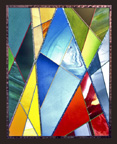 Septaplex X
Septaplex X
1978-79
38.5" h x 28.5" w
Glass, paint, glitter, metals |
|
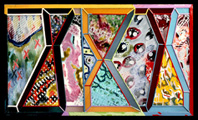 Undecaplex X
Undecaplex X
1978-79
16" h x 26" w
Kiln-fired paint on glass, paint, metals |
|
|
Susan Stinsmuehlen-Amend
"In the late 70's and early 80's, coming out of a fine arts education in painting and employment at a glass studio, I became intrigued by glass for it's ambiguous nature as a support for paint. Adding imagery on both sides of the glass, created a literal depth not possible with paint on canvas. Mixed media was often combined with the glass to create a rich texture of color, pattern and meaning," says Stinsmuehlen-Amend of this work, which denied the truth-to-material philosophy typical of the craft world at the time.
These formative works, influenced by the punk scene, Pattern and Decoration and Neo-Expressionism in painting, as well as the ongoing innovations in the world of craft, led to work that was unrestrained, kinetic, frenetic, glittery and jarring. The X appears in these early works as a symbol and image of attempting to destroy existing preconceptions about flat glass, specifically stained glass. A sign used in cultures throughout the world, the X is often associated with caution, the unknown, denial, error or a crossing out. Arts writer Ben Marks in an article from GLASS Magazine (1992) described her use of the X as "a means by which the artist could rail against and obliterate, well, whatever needed railing and obliteration: the memory of old boyfriends, too much pizza, too much Texas and, of course, far too much art nouveau. Typically her pieces were exercises in information overload, an assault of pattern and decoration applied, seemingly, by hand grenade." The conventions and history of stained glass were turned upside down.
Typically, the work has always expressed a type of story. Images, words, and materials depict personal experiences that refer to universal concerns. The narrative tradition of stained glass nurtures the continuing interest in painting on glass and vice versa.
Susan Stinsmuehlen-Amend, a past board member of the Glass Art Society (1982-86) and an Honorary Life Member, served as the organization's first woman president. Her work in glass and mixed media, architectural glass, hot glass and public art is included in many private collections and public collections. A Trustee Emeritus of The American Craft Council, she currently serves as Chair of the Arts Commission for the City of Ojai. She is a past recipient of two National Endowment for the Arts Fellowships, the Pilchuck Glass School Hauberg Fellowship, the 2007 Libensky Award, and 2006 Artist Residencies at Pilchuck and the Museum of Glass, Tacoma, Washington.
| |
 Diptych
Diptych
1973
Acrylic/canvas
51" x 32"
|
|

Untitled
1976
Acrylic/unprimed canvas
16" x 32"
|
|
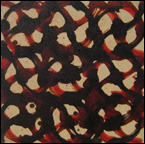 Untitled
Untitled
1980
aniline dye/unprimed canvas
24" x 24" |
|
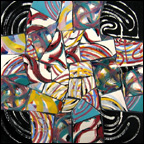 Untitled
Untitled
1984
Ceramic tile/plywood
30" x 30" |
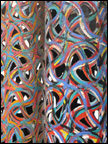 Untitled
Untitled
1985
Acrylic/sonotube
96" x 18" x 18" |
Richard Amend
Richard Amend was born in New York and received a BFA from Cooper Union. He moved to Los Angeles with a full scholarship to the California Institute of the Arts Graduate Program as a conceptual artist in 1971. He promptly changed course to concentrate on painting, earning an MFA in 1973.
Amend's work, beginning in the seventies, focused on systemic procedures influenced by Perceptual Psychology, Op, and Minimalism. He used simple concepts like division and rotation, and how these applied to color, light, form, and space, all approached with equal abstraction. From an interview in the catalogue for his exhibition at Galleria Lorenzelli in Milan in 1977 Richard stated:
"my work is concerned with the interrelationship between color and pattern. where does color delineate pattern and where does pattern define color? the manipulation of two basic systems results in a nearly infinite exploration. through these simple means the precision of expression and the emotion of the moment are on display. a spectrum of pure color is altered by impressions and transformed into a private spectrum. the systems are open-ended and continuous, yet unique at every junction. The repetition is not repetitious, but revealing."
In the 80's, painting became more passionate and physical. Broader, curvilinear strokes expressively defied the grid. Amend's work, still an investigation of forms, seemed to temporarily relate to the Pattern & Decoration movement, as witnessed by his inclusion in the Oakland Museum exhibition "On and Off the Wall: Shaped and Colored" in 1983.
Amend's concurrent career in film led to extensive travel and location scouting. In the process of photographing sites and designing sets for various projects, he found a new opportunity for painting, one based on photographic recollection. His conceptually composed images now include very particular landscapes and architectural fragments painted by bringing illumination and form out of the murkiness of a dark canvas, a slightly film noir, cinematic convention.
Retro-Perspectives: Richard Amend & Susan Stinsmuehlen-Amend, Selected works from the Seventies and Eighties presents a lively cross-section of sometimes complimentary, sometimes divergent, cultural intersections experienced by the artists, explored prior to meeting in 1987.
|